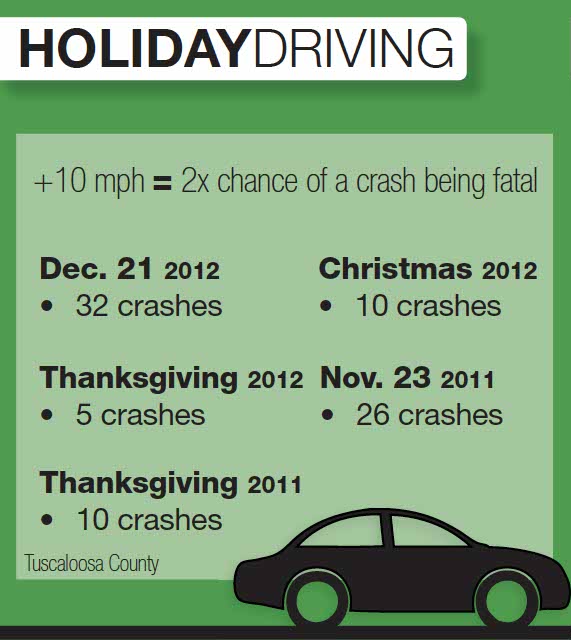The holidays are a time for family, gifts and celebration, but car accidents can be a side effect in the days just before Christmas, according to a recent UA study.
“There will be many people whose holiday season is ruined by the loss of a loved one, the pain of injury or just the terrible inconvenience [of] being involved in a crash at this time of year,” said David Brown, a research affiliate at UA’s Center for Advanced Public Safety.
A study conducted by CAPS using its custom analysis system, Critical Analysis Reporting Environment, has found the number of crashes in the days just before Christmas was significantly higher than the number before or after Thanksgiving and New Year’s Eve.
CARE was distinctive among other studies, Brown said, since it was easily able to find certain types of crashes and identify their most critical aspects.
“In this case, the ‘certain type of crashes’ were crashes that occurred a few days before or after the three holidays,” he said. “CARE can automatically compare these types of crashes against others to determine what might be different about these crashes, and thus enable law enforcement to concentrate on those aspects that are most critical.”
CARE, which is available online to be used by the public, reports 32 crashes in Tuscaloosa County on Dec. 21, 2012, compared to 10 on Christmas Day and five on Thanksgiving. In 2011, there were 26 crashes on Nov. 23 and 10 on Thanksgiving.
“The safest days to travel are on the holidays themselves,” Brown said.
Brown said students should do their Christmas shopping early so as to avoid being on the roads during the days just before the holiday.
“Try to avoid days where it is wet, and especially if there is any snow or ice,” Brown said. “These are always very bad days for traffic problems and crashes.”
Brown advises students to follow simple rules like using a seat belt, regardless of trip length, and observing the speed limit.
“That little extra speed will generally not get you there five minutes faster,” he said. “Every 10 miles per hour of impact speed doubles the chance of a crash being fatal.”
Other important safety rules of the road include not texting while driving and not drinking or taking any kind of drugs that might affect competency. Brown also advised drivers to avoid tailgating or impulsive movements like cutting other vehicles off.
Brian Swiney, safety education specialist at the University of Montevallo’s Alabama Traffic Safety Center and a UA graduate, said students need to be aware of the many possible distractions they may encounter.
Swiney encouraged students to be wary of things that “talk” to them – whether that’s a passenger, a cellphone or even a GPS – and to be aware of pedestrians who might be distracted by a cellphone.
“Technology has put us in all in quite a bind,” Swiney said. “That’s the biggest concern on the forefront right now, especially with [the 16-24] age group.”
The 16-24 age group, Swiney said, is the most at-risk group. Good driving – and lower insurance rates – can take eight years to set in.
“A lot of habits have to be broken,” Swiney said.
Students can also maximize their holiday driving safety by planning safe routes home. Swiney said county roads and state highways are statistically the most dangerous for drivers.
“A lot of people think the interstate is probably the worst place to drive when in fact it’s the safest place,” Swiney said.
Drivers who have no other options need to watch out for roads without shoulders, deer, cars crossing the median and take care around hills and turns.
According to the 2011 Alabama Crash Facts Book produced by CAPS, speeding and drunken driving both caused 220 deaths. Failure to yield right of way caused more than 19,000 crashes. Brown said the most recent study set out to determine the who, what, when, where and why of crashes around the three major holidays in the fall semester.
“We would like the general public to observe the results that we got and make more intelligent decisions with regard to their holiday travel,” Brown said. “It is one major mission of the Center for Advanced Public Safety to reduce crashes and save lives at any time.”









